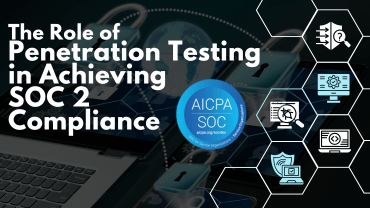The Role of Penetration Testing in Achieving SOC 2 Compliance
Data security and penetration testing go hand in hand when it comes to trying to achieve (and maintain) compliance with SOC 2 – one of the most widely-accepted security frameworks globally.
SOC 2 (Service Organization Control 2) compliance assesses how well an organization protects and manages customer data, focusing on the five SOC 2 trust service principles (TSP) which include: security, availability, processing integrity, confidentiality, and privacy. As part of this assessment, a SOC 2 auditor evaluates the security controls that you have put in place to safeguard customer data to ensure they meet the required security standards. Penetration testing – often referred to as “pen testing” – plays a key role in identifying vulnerabilities within information security systems. Given its importance, many companies question whether SOC 2 requires penetration testing as part of its compliance framework.
In this article, we dive into how penetration testing fits into the SOC 2 compliance journey, why it’s necessary, the various types of penetration testing, and how innovative SOC 2 compliance software can streamline the entire process, making your path to SOC 2 compliance a whole lot smoother.
What is Penetration Testing in SOC 2 Compliance?
Before we go any further, let’s specify exactly what penetrating testing is. Penetration testing is a method used to evaluate the security of an information system by simulating an attack from malicious outsiders (and insiders). The testing aims to identify and fix any weaknesses that could be exploited at a later stage. Pen testing is typically conducted by security experts – also known as “ethical hackers” – whose main purpose is to spot vulnerabilities in your system, processes, applications, or networks before real hackers can take advantage of them.
Penetration testing often involves both automated and manual efforts. Although automated scans are useful in identifying known security issues or patterns, the manual aspect of pen testing takes it to another level, enabling a more sophisticated, targeted approach to revealing vulnerabilities. This approach mirrors a real-world attack, carrying out a cyberattack just as a real hacker might do, and is beneficial as it helps to highlight certain issues that purely automated tools might overlook.
Why Penetration Testing is Important for SOC 2 Compliance
For SaaS companies, protecting customer data is a top priority. Through SOC 2 penetration testing, organizations can assess how well they’re adhering to the strict security standards set out by SOC 2, and make improvements where needed. It’s not only about keeping up appearances, it’s about making sure your business is truly secure.
Although penetration testing isn’t explicitly required by SOC 2, it is highly recommended and often considered a best practice for showcasing a robust security posture.
Here’s why it matters:
- Demonstrating Security Posture: Penetration testing provides tangible proof that an organization’s security measures are effective. This is especially useful during a SOC 2 audit as evidence is required to demonstrate compliance with the security trust services criteria (TSC).
- Proactive Risk Management: Regular penetration testing allows organizations to identify and address vulnerabilities before they can be exploited by malicious hackers. This proactive approach not only helps to reduce risks but is also in line with the main SOC 2 objective of maintaining strong security controls.
- Building Customer Trust: In today’s digital environment, customers are increasingly concerned about the security of their data. By conducting regular penetration tests and addressing any identified issues, companies can strengthen trust with their customers and partners, as well as differentiate themselves in a competitive market.
- Supporting Continuous Improvement: Penetration testing is not a one-time activity but an ongoing process. Regular tests and required remediation efforts contribute to the continuous improvement of an organization’s security posture, which is a key aspect of SOC 2 compliance.
As evidenced above, penetration testing plays a vital role in helping your business mitigate risk, protect sensitive customer data from security threats, and ensure your security posture remains intact at all times – all while helping you get one step closer to becoming SOC 2 compliant.
Types of Penetration Testing
There are various types of penetration testing that focus on different areas of your system. The type of penetration testing you choose depends on the scope of the assessment and what you’re looking to achieve.
Below are the different types of penetration testing to consider as part of your journey to SOC 2 compliance:
Black Box Testing
In black box testing, testers go in blind – they have no prior knowledge of the system’s architecture or code. This approach mimics an external hacker’s unique perspective. Testers try to break in without any inside information, giving you an understanding of how a real-life attacker might infiltrate your defenses.
White Box Testing
In contrast, white box testing gives testers full access to the system’s architecture and source code. This approach allows for a deep exploration into the security landscape, helping to identify vulnerabilities that might go unnoticed in a black box test. By seeing everything from the inside, testers can zone in on potential security shortcomings more thoroughly.
Gray Box Testing
As the name suggests, gray box testing falls somewhere in between black box and gray box testing. Testers are given some knowledge of the system – maybe access credentials or a few details about the infrastructure. This method allows testers to simulate an attack from both the inside and outside, helping to spot vulnerabilities that might not be very obvious using only one of the approaches.
What about Automated Penetration Testing?
For larger systems or when time is limited, automated penetration testing, also known as vulnerability scans, can be a lifesaver. Using specialized tools, automated pen testing can simulate a wide variety of cyberattacks quickly and at scale. While automated tools certainly can’t replace the value of human insight, they’re perfect for running broad scans to identify known vulnerabilities before conducting a more thorough manual evaluation.
Streamlining the SOC 2 Compliance Process
Penetration tests can be quite the task. However, with the help of powerful SOC 2 compliance software, you can streamline the process, benefiting from simplified penetration testing while automating your entire compliance workflow from start to finish. By doing so, you can save valuable time and resources, while also ensuring your business remains protected and audit-ready all year round.
Closing Thoughts
While SOC 2 does not explicitly mandate penetration testing for your organization to achieve compliance, it is a highly recommended practice, and is a key component of a comprehensive security strategy that aligns well with SOC 2 objectives. Pen testing provides valuable insights into your organization’s security vulnerabilities and demonstrates your proactive approach to risk management. This commitment is essential for both achieving and maintaining SOC 2 compliance.
In summary, if your business is pursuing SOC 2 compliance, you should consider integrating regular penetration testing into your security practices to not only help you meet SOC requirements but also enhance your overall security posture and build trust with both existing and prospective customers.





